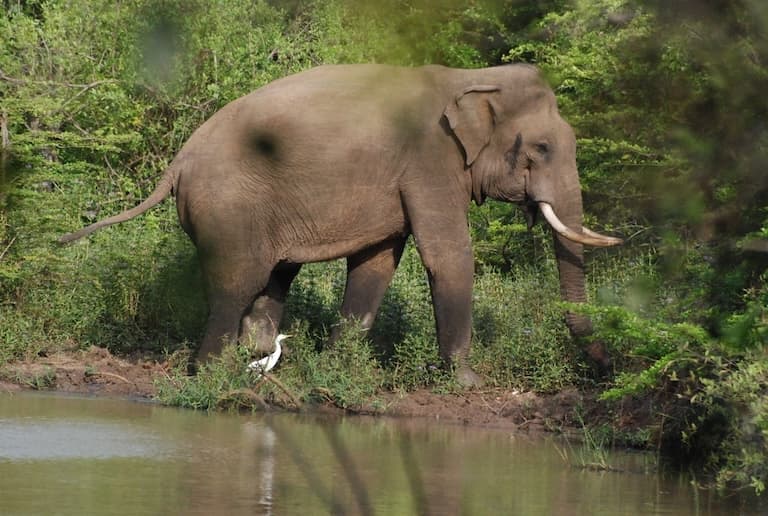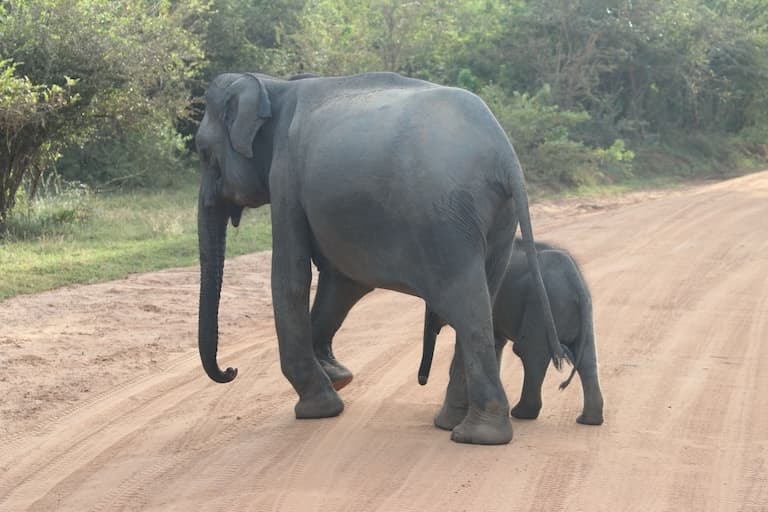Sri Lankan Elephant Profile
During the Pleistocene, elephants reached their peak. Spanning the vast majority of the landmasses on the planet and branching into tens of species, they were, as they are today, the largest land animals in the world. Sadly, we’re down to just three species now, and one of these, the Asian elephant, is not only dwindling in number but has a history of imprisonment and abuse that’s hard to shake.
The Sri Lankan Elephants, one of the three subspecies in Asia, are a great example of the two-way danger of large animals sharing their habitats with modern humans and the positive effects of conservation on correcting this.

Sri Lankan Elephant Facts Overview
| Habitat: | Mostly lowlands, dry zones |
| Location: | Sri Lanka |
| Lifespan: | 60+ years |
| Size: | Around 3 metres, rarely up to 3.7 metres |
| Weight: | Usually up to 3.5 tonnes; rarely up to 7 tonnes |
| Colour: | Grey, with pinkish patches of depigmentation on the head and face |
| Diet: | Generalist herbivores, able to graze and browse |
| Predators: | Few; mostly humans, occasionally tigers |
| Top Speed: | 20 km/h |
| No. of Species: | 1 |
| Conservation Status: | Endangered |
There’s perhaps nothing more symbolic of our conceited position in the ecosystem than a chained elephant. Indian elephants have been captive animals for thousands of years, but their servitude pales in the face of persecution in the wild, which threatens to wipe out the species entirely. Sri Lanka has the highest per capita human casualties as a result of this human-wildlife conflict, and therefore is a critical place to identify and correct issues that we have with animal populations all over the world.
Interesting Sri Lankan Elephant Facts
1. They’re the largest Asian elephant
Asian elephants are smaller than their African cousins, in large part because they descend from a totally different line of elephants. In Asia, the elephants are more closely related to the extinct mammoths than the African elephants, and hold the fort as the final remnants of a once-widespread, prehistoric megafauna.
There are three accepted subspecies in Asia: the Indian, Sumatran and Sri Lankan elephants. The Sri Lankan is distinguishable on account of its darker skin, and is the largest of the three, averaging around four or five tonnes in large bulls, but has been recorded reaching 7 tonnes and 3.43 metres tall.

2. They’re prone to Dwarfism
In 2013, a Sri Lankan elephant became the first recorded wild elephant to be confirmed to have dwarfism1.
While other subspecies have natural, non-human predators in their ranges, those in Sri Lanka no longer do, and so this dwarf elephant wasn’t subjected to the same treatment as dwarf members of its relatives would be, by way of the tiger.
As such, it probably still exists, though little is known about these elephants in general, and their protection is an ongoing and difficult process.
3. They’re an umbrella species
Asian elephants are enormous, eat a huge amount (up to 150 kg per day) and have immense natural ranges of up to 400 square kilometres. This means they affect a vast number of other species, as well. Many of the 60 species of plants they eat, within around 30 different families, make use of these gassy meat tanks to spread their seeds. Their tremendous poops are rich fertiliser for all kinds of growth, and where there are elephants, business is good for dung beetles and other detritivores too; therefore, everything that eats those is also going to do well2.
This makes elephants a brilliant place to focus conservation efforts, as their protection naturally cascades into the protection of other species.
4. They have vitiligo
Asian elephants can often be seen in captivity, all dressed up in traditional garb, and in these settings, many have depigmented patches on their skin.
Sri Lankan elephants appear to have this the most, though it is present in the other two subspecies, as well. It’s not clear what causes this, but it’s much harder to spot in wild populations, due to their practice of rolling in mud to protect their skin.
Depigmented faces and heads are one way to tell individuals apart from one another, as the patterns are unique to the individual3.
5. They growl
If you’re ever lucky enough to be near a wild elephant without it killing you, you might find that the growl is just as memorable as the sheer mass of the beast. This prehistoric sound can resonate in your chest like a cathedral organ – and for the same reason.
These low growls are barely audible to our ears, and most of the sound is, in fact, beneath the audible threshold and considered infrasound.
They are the long-distance calls that elephants make to one another, sending sound waves through the ground over several kilometres, sharing information about their worlds in a language we have yet to decipher.
And this very behaviour represents everything that we don’t see in elephants and animals in general. Here is an intelligent, social animal, not all that different from us, with its own wants and opinions, and understanding this is a step closer to learning to live with them.
6. They’re not as dangerous as they seem
Let’s start this one off with a disclaimer: elephants are incredibly dangerous animals. In Africa, they kill more people than the infamous hippos. In India, around 150 people are killed each year, yet this is around a third of the elephants killed in return. In Sri Lanka, the ratio is even worse. For every 80 people killed by elephants, 250 elephants are killed.
Elephants are duly feared for this danger, but the fear is overblown. This is in no small part because it’s a lot harder to step on an elephant by mistake, and so they kill a tiny fraction of the number of snakes do in the same regions.
But fear is an important hurdle to overcome with elephant conservation, and while it’s overblown, it’s also justified to an extent. Elephants do kill people, and to make matters worse, they raid crops, bringing them into direct conflict with people4.

7. Human wildlife conflict
And this is the root of our species’ seeming inability to coexist with anything meatier than a turnip. In the case of Sri Lankan elephants, we have two large, aggressive species that eat the same food and live in the same place. It’s basic ecological competition, and unfortunately, the humans are “winning”.
The trouble with winning to the degree that we do, is that it’s a very short-term win, as ecological collapse will doom everything over 10kg to extinction, as it has done continually throughout Earth’s history.
So, preventing this from happening requires us to think in more nuanced terms and work towards equilibrium with nature, rather than perfect dominance over it.
In Sri Lanka, forest coverage has decreased to 15%, from 70% in the 1920s. This obviously reduces habitats, but also ramps up cases of elephants coming to farmland for food, and can only end badly for the elephant.
The good news is that the population trend is positive.
8. They’re making a slow return
In the 1800s, British colonialism brought with it trophy hunting and government eradication programs against this subspecies in Sri Lanka. Thousands were killed each year, and their population dropped from over 20,000 in the 19th Century, to below 2,000 in 1993.
But most recent estimates have seen that figure return to above 7,000, split between some dangerously fragmented populations, but many viable ones, nonetheless. Captive breeding is also underway, and legal reforms are slow, but ongoing, too.
There is hope for this subspecies, but a lot of work still needs to be done to create an environment where humans and other animals tolerate one another more sustainably.

Sri Lankan Elephant Fact-File Summary
Scientific Classification
| Kingdom: | Animalia |
| Phylum: | Chordata |
| Class: | Mammalia |
| Order: | Proboscidea |
| Family: | Elephantidae |
| Genus: | Elaphus |
| Species Name: | E. maximus maximus |
Fact Sources & References
- Claire Salisbury (2013), “Little elephant is the first scientific record of dwarfism in the wild”, Mongabay.
- Williams et al (2020), “Asian Elephant”, The IUCN Red List of Threatened Species in 2019.
- Sooriyabandara et al (2023), “Genetic features of Sri Lankan elephant, Elephas maximus maximus Linnaeus revealed by high throughput sequencing of mitogenome and ddRAD-seq”, National Library of Medicine.
- (2016), “Mapping the Risk of Snakebite in Sri Lanka – A National Survey with Geospatial Analysis
”, National Library of Medicine.
